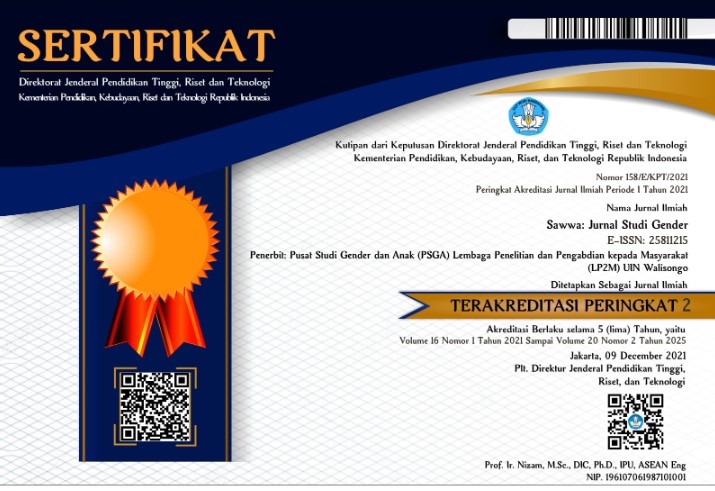Gender-sensitive Architecture: Assessing Space Qualities and Perceptions in Housing Design
DOI:
https://doi.org/10.21580/sa.v20i1.25288Keywords:
housing design, gender perspective, gender-sensitive design, space function and quality, spatial needsAbstract
Housing designs should not only consider aspects of form and function but should also pay attention to gender perspectives. This study aims to examine the influence of gender perspectives on the architectural design of residential housing. Employing a mixed method of a qualitative approach and a questionnaire-based online survey, this research explores user perceptions and preferences in applying gender-sensitive approaches to housing design. The findings reveal that gender-sensitive approaches are highly preferred in housing designs, with a particular emphasis on accommodating the inhabitants’ needs. The approach effectively addresses the specific needs of masculine and feminine individuals as inhabitants, which can significantly improve the quality of life within the house. This research emphasizes the urge to incorporate a gender perspective as one of the design considerations to create inclusive houses that are responsive to the needs of individuals of diverse genders.
Downloads
References
Aryanti, Tutin. “Vision and Gendered Space: Making Women Invisible in Yogyakarta Sultanate Palace.” Space and Culture 20, no. 3 (2017): 301–14. https://doi.org/10.1177/1206331216647353.
Borden, Iain, Barbara Penner, and Jane Rendell, eds. Gender Space Architecture. Routledge, 2002. https://doi.org/10.4324/9780203449127.
Bourdieu, Pierre. “The Social Space and the Genesis of Groups.” Social Science Information 24, no. 2 (1985): 195–220. https://doi.org/10.1177/053901885024002001.
Chadha, Trishla. “Characteristics of Gender Sensitive Architecture.” Re Thinking the Future, 2024. https://www.re-thinkingthefuture.com/designing-for-typologies/a3709-characteristics-of-gender-sensitive-architecture/.
Corbin, Juliet M., and Anselm Strauss. “Grounded Theory Research: Procedures, Canons, and Evaluative Criteria.” Qualitative Sociology 13, no. 1 (1990): 3–21. https://doi.org/10.1007/BF00988593.
Creswell, John W., and Cheryl N. Poth. Qualitative Inquiry and Research Design: Choosing among Five Approaches. Thousand Oaks: SAGE Publications Inc., 2013.
Fakriah, Nurul. “Hijab: Konsep Gender Space dalam Arsitektur Vernakular Aceh.” Gender Equality: International Journal of Child and Gender Studies 6, no. 1 (2020): 109–20. https://doi.org/10.22373/equality.v6i1.6597.
Faturahman, Hilal Akbar, and Retno Dwiyanti. “Fear of Success in Women Working with the Banyumas Cultural Approach.” Sains Humanika 13, no. 2–3 (2021): 358–64. https://doi.org/10.11113/sh.v13n2-3.1909.
Ferrari, Gisela, Victoria Stanley, and Michelle Morandotti. Addressing Gender Gaps in Housing Interventions. Washington D.C: International Bank for Reconstruction and Development / The World Bank, 2021.
Hashemnezhad, Hashem, Seyed Abbas Yazdanfar, Ali Akbar Heidari, and Nazgol Behdadfar. “Comparison the Concepts of Sense of Place and Attachment to Place in Architectural Studies.” Australian Journal of Basic and Applied Sciences 7, no. 1 (2013): 219–27.
Hastuti, Dhian Lestari, Achmad Syarief, Imam Santosa, and Pribadi Widodo. “Pracimosono as a Place of Intimacy and Spiritual Experience for the Mangkunegaran Princesses in Surakarta, Indonesia.” International Society for the Study of Vernacular Settlements 10, no. 8 (2023): 15–38. https://doi.org/10.61275/ISVSej-2023-10-08-02.
Hendy, Amany. “Gender Differences Necessities in Interior Design.” International Design Journal 5, no. 3 (2015): 1293–1302. https://doi.org/10.21608/idj.2015.101786.
Imran, Md. “Understanding the Gender Implications of Architecture.” tbs news, May 28, 2024. https://www.tbsnews.net/features/habitat/understanding-gender-implications-architecture-862421.
Isaac, Janine. “Home is where the female is: Analysing the Geography of Gender Inequalities and the Home.” Topophilia, October 1, 2020, 32–36. https://doi.org/10.29173/topo25.
ITS News Admin. “Menelisik Unsur Feminisme di Dunia Arsitektur.” ITS News, March 20, 2018. https://www.its.ac.id/news/2018/03/20/menelisik-unsur-feminisme-di-dunia-arsitektur.
Maunganidze, Langtone. Representation and Materialization of Architecture and Space in Zimbabwe. Cham: Springer Nature Switzerland, 2024. https://doi.org/10.1007/978-3-031-47761-4.
Mhatre, Vrushali. “Masculine or Feminine: Designing Gender-Neutral Spaces.” Edited by Roma Arora. Design Middle East, March 8, 2023. https://design-middleeast.com/masculine-or-feminine-designing-gender-neutral-spaces/.
Moleong, Lexi J. Metodologi Penelian Kualitatif. Bandung: Remaja Rosdakarya, 2014.
Navarrete-Hernandez, Pablo, Arielle Vetro, and Paz Concha. “Building Safer Public Spaces: Exploring Gender Difference in the Perception of Safety in Public Space through Urban Design Interventions.” Landscape and Urban Planning 214 (2021): 104180. https://doi.org/10.1016/j.landurbplan.2021.104180.
Purnomo, Agus. “Teori Peran Laki-laki dan Perempuan.” Egalita: Jurnal Kesetaraan dan Keadilan Gender 1, no. 2 (2006). https://doi.org/10.18860/egalita.v0i0.1920.
Rachels, James, and Stuart Rachels. “The Challenge of Cultural Relativism.” In The Elements of Moral Philosophy, 15–29. New York: McGraw-Hill Education, 2018.
Sari, Yeptadian, and Nabila Azzura Putri Prasyam. “Kajian Konsep Arsitektur Gender pada Rumah Tinggal Wanita Pasca Bersalin.” In Prosiding Semnastek, 1–6, 2021. https://jurnal.umj.ac.id/index.php/semnastek/article/view/11478.
Sunarmi, Sunarmi. “Pendekatan Pemecahan Desain Interior Rumah Tinggal.” Ornamen 10, no. 1 (2013): 41–56.
Teerds, Hans, and Tom Avermaete. “The Roles of the Architect: Toward a Theory of Practice.” In Lexicon No. 1: On the Role of the Architect, 7–11. Delft: The Berlage Center for Advanced Studies in Architecture and Urban Design, 2015.
Terraza, Horacio, Maria Beatriz Orlando, Carina Lakovits, Vanessa Lopes Janik, and Anna Kalashyan. Handbook for Gender-Inclusive Urban Planning and Design. Washington D.C: World Bank Group, 2020. https://openknowledge.worldbank.org/bitstream/handle/10986/33197/145305.pdf.
Utami, Farah Widya, and Fairuz Mutia. “Keterkaitan Aspek Sense of Place dalam Pembentukan Perilaku Wanita sebagai Pengguna Bangunan.” Sinektika: Jurnal Arsitektur 20, no. 1 (2023): 82–89. https://doi.org/10.23917/sinektika.v20i1.20085.
Walker, Lynne. “Home Making: An Architectural Perspective.” Signs: Journal of Women in Culture and Society 27, no. 3 (2002): 823–35. https://doi.org/10.1086/337927.
Xu, Zhixin, Xia Huang, Xiaoming Li, and Chenhao Duan. “Interaction between Gender and Space: A Study on the Genealogy of Feminist Architecture.” Buildings 14, no. 11 (2024): 3658. https://doi.org/10.3390/buildings14113658.
Downloads
Published
Issue
Section
License
Copyright (c) 2025 Sawwa: Jurnal Studi Gender

This work is licensed under a Creative Commons Attribution-ShareAlike 4.0 International License.
The copyright of the accepted article shall be assigned to the journal as the publisher of the journal. The intended copyright includes the right to publish the article in various forms (including reprints). The journal maintains the publishing rights to the published articles.
In line with the license, authors and third parties (readers, researchers, and others) are allowed to share and adapt the material. In addition, the material must be given appropriate credit, provided with a link to the license, and indicated if changes were made. If authors remix, transform or build upon the material, authors must distribute their contributions under the same license as the original.











